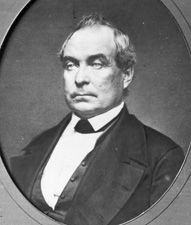| Silas Wright  AKA Silas Wright, Jr. AKA Silas Wright, Jr.
Born: 24-May-1795
Birthplace: Amherst, MA
Died: 27-Aug-1847
Location of death: Canton, NY
Cause of death: unspecified
Remains: Buried, Old Canton Cemetery, Canton, NY
Gender: Male
Race or Ethnicity: White
Sexual orientation: Straight
Occupation: Politician
Party Affiliation: Democratic Nationality: United States
Executive summary: US Senator from New York, 1833-44 The American politician Silas Wright was born in Amherst, Massachusetts on 24 May 1795. His early life was spent on his father's farm in Weybridge, Vermont, and after graduation at Middlebury college in 1815 he studied law, was admitted to the bar, and began practice in Canton. In 1820 he was appointed surrogate of St. Lawrence County, and in 1823-7 he was a member of the state senate, where he opposed the political advancement of De Witt Clinton, regarding it as dangerous to the Democratic party, of which he was a firm adherent throughout his life. In 1827 he made a report to the senate developing the financial policy with which he was identified throughout his life, and which he subsequently enforced as a political measure, while he was Governor of New York. In 1827 he was made brigadier-general of the state militia. He served in Congress from 3 December 1827 until 3 March 1829, and there voted for the protective tariff of 1828, and for the appointment of a committee to inquire into the expediency of abolishing slavery and the slave-trade in the District of Columbia. In 1829 he was appointed comptroller of New York, which office he held until 1833, when he was chosen to the United States Senate in place of William L. Marcy. In that body he served on the committee on finance, supported the force bill and Henry Clay's compromise bill of 1838, introduced the first sub-treasury bill, which became a law, defended President Andrew Jackson's removal of the deposits from the U.S. Bank, and delivered a speech opposing Daniel Webster's motion to recharter that institution. He also voted against receiving a petition for the abolition of slavery in the District of Columbia, and in favor of excluding from the mails all "printed matter calculated to excite the prejudices of the southern states in regard to the question of slavery." Wright opposed the distribution among the states of the surplus Federal revenues, supported the independent treasury scheme of Martin Van Buren, maintained in reference to the abolition of slavery the right of petition and the sovereignty of Congress over the territories in 1838, and voted for the tariff of 1842 and for the annexation of Texas. His term extended from 11 January 1833, until 1 December 1844, when he resigned to become Governor of New York, which post he held until 1847, during which period he opposed the calling of a convention to revise the state constitution, vetoed a bill to appropriate money for canal improvements, and took decided ground against the anti-rent rioters, declaring Delaware county in a state of insurrection and calling out a military force. He was defeated as candidate for re-election in 1846. When in April 1847, the application of the Wilmot Proviso to the territories that had been obtained from Mexico was under discussion, Wright emphatically declared that the arms and the money of the Union ought never to be used for the acquisition of territory for the purpose of planting slavery. In May 1847, he wrote a letter expressing himself in favor of using the money of the Federal government to improve the harbors of the northern lakes. He refused several offers of cabinet offices and foreign missions. After his term as Governor he retired to his farm in Canton, which he cultivated with his own hands. Wright died in Canton, St. Lawrence County, New York, on 27 August 1847. His mind was logical and powerful, and he was considered a clear and practical statesman. Horatio Seymour said: "Mr. Wright was a great man, an honest man; if he committed errors, they were induced by his devotion to his party. He was not selfish; to him his party was everything -- himself nothing." For thirty years Wright's likeness appeared on the U.S. $50 gold certificate. There is a good portrait of him by James Whitehouse in the New York City Hall. See Eulogy on Silas Wright, by Henry D. Gilpin (Philadelphia, 1847); his Life and Times, by Jabez D. Hammond (Syracuse, 1848); and his Life, by John S. Jenkins (Utica, 1852.)
University: Middlebury College, Vermont (1815)
Governor of New York (1845-47)
US Senator, New York (1833-44)
US Congressman, New York 20th (1827-30)
New York State Senate 4th (1824-27)
Portrait on American currency $50 gold certificate
Requires Flash 7+ and Javascript.
Do you know something we don't?
Submit a correction or make a comment about this profile
Copyright ©2019 Soylent Communications
|